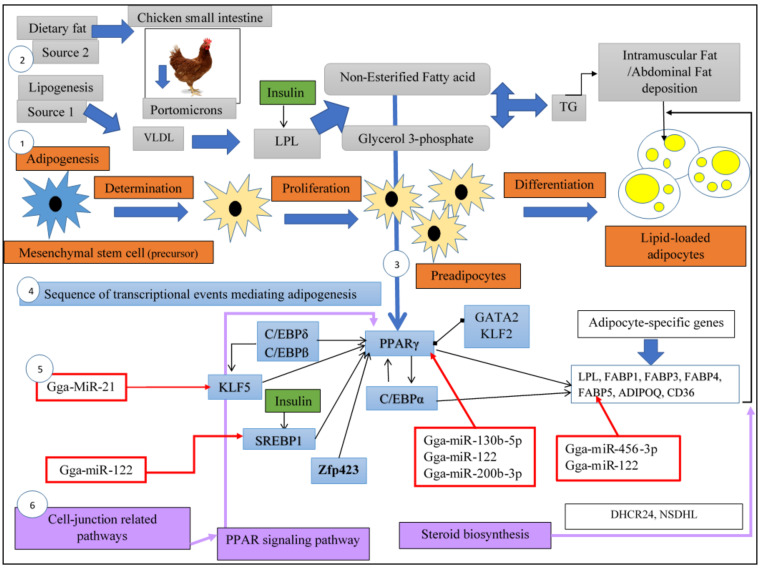Figure 2.
Schematic representation of adipogenesis and fat deposition and their regulation at the transcriptional and post-transcriptional level in the chicken adipocyte. Several regulatory factors, including hormones (green boxes), transcriptional factors (blue boxes), miRNAs (red boxes), and their target genes, controlling adipogenesis and fat deposition in chicken. 1—Adipogenesis (orange boxes) is the process of differentiation in which mesenchymal cells turn into mature adipocytes. 2—The fatty acids released from VLDL can penetrate adipocytes, which inside adipocytes resynthesized into TG and deposited. Accumulated fat in chicken adipose tissue consists of TG either from plasma VLDL (source 1) or from dietary fats (portomicrons) (source 2). 3—The presence of exogenous fatty acids (from VLDL or diet) is vital for regulating the expression of peroxisome proliferator-activated receptor-γ (PPARγ). 4—The blue boxes revealed the sequence of transcriptional factors controlling adipogenesis; the early transcriptional regulators, including CCAAT/Enhancer binding-protein (C/EBPβ and C/EBPδ) express and stimulate the key transcription factors, including PPARγ and C/EBPα which at terminal differentiation stage, regulate the transcriptional regulation of a variety of adipocyte-associated genes, such as lipoprotein lipase (LPL), fatty-acid-binding proteins (FABP), cluster of differentiation 36 (CD36), and adiponectin, C1Q and collagen domain-containing (ADIPOQ). PPARγ and C/EBPα are the master regulators of adipogenesis that can crossregulate each other. Sterol response element-binding protein (SREBP1) is regulated by insulin and can regulate adipogenesis by inspiration the expression of PPARγ through adipogenesis. Kruppel-like transcription factor (KLF5) is activated by C/EBPβ/δ through the early stages of adipogenesis and then promotes the expression of PPARγ. KLF2 and GATA binding protein 2 (GATA2) are the anti-adipogenic transcription factors, which lead to adipogenesis repression through inhibition of the expression of PPARγ. Zinc finger protein 423 (Zfp423) regulates preadipocyte cell determination through regulation of PPARγ expression. 5—The red boxes indicated various significantly expressed miRNAs with regulatory effects on adipogenesis. 6—Fat deposition in chicken is mediated and regulated by different signaling pathways (purple boxes), including the PPAR signaling pathway and the cell junction pathways (focal adhesions, tight junction, ECM-receptor interaction, regulation of actin cytoskeleton). The cell junction-related pathways may mediate the PPAR signaling pathway after activating PPARγ. Then PPARγ upregulates the expression of lipogenic-related genes, such as FABP3, LPL. The steroid biosynthesis pathway through regulating the expression of genes, such as 24-dehydrocholesterol reductase (DHCR24) and NAD(P) dependent steroid dehydrogenase-like (NSDHL), might play a dominant role in fat deposition in chicken (). Open arrows and diamond arrows represented the stimulating and inhibition effects, respectively.

